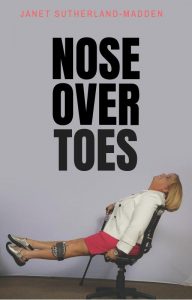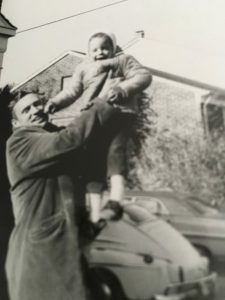 In 2004, Janet Sutherland left work early to walk her dog Bogie after a grueling day knocking door to door selling radio ads. She was suddenly struck with the worst headache of her life. Sutherland had suffered a ruptured brain aneurysm. On March 22, 2004, as friends and family sat at Janet’s bedside, she was given a three percent chance to live. For weeks her co-workers raised money for her family, joined her battle, and prayed she would survive. 15 years later, Sutherland has miraculously recovered. NOSE OVER TOES tells the story of her recovery and includes research from The Brain Aneurysm Foundation.
In 2004, Janet Sutherland left work early to walk her dog Bogie after a grueling day knocking door to door selling radio ads. She was suddenly struck with the worst headache of her life. Sutherland had suffered a ruptured brain aneurysm. On March 22, 2004, as friends and family sat at Janet’s bedside, she was given a three percent chance to live. For weeks her co-workers raised money for her family, joined her battle, and prayed she would survive. 15 years later, Sutherland has miraculously recovered. NOSE OVER TOES tells the story of her recovery and includes research from The Brain Aneurysm Foundation.
The trade paperback of Nose Over Toes is being released on the 15th anniversary of Janet’s aneurysm, March 22, 2019. It can pre-ordered at www.eckhartzpress.com.
We recently sat down with Janet to talk to her about her book…
EP: I’m sure you’ve heard this question before, but what is the significance of the title Nose Over Toes?
Janet: Nose over toes is how my physical therapist would direct me to stand up to get out of my chair. It was also how my figure skating teacher told me to stand up straight. It’s really for any people who have trouble walking or standing up. Nose over toes is the key phrase.
EP: The thing that really grabbed at my heartstrings while I was reading the book was the role your parents played in your recovery. I know it’s hard to sum up, but how would you describe their roles?
 Janet: My parents never left my side. They were my rock during recovering. My Dad was my drill sergeant when I got home, making sure I continued my exercise. My mom made sure I stayed on a healthy diet and got back into a normal life routine so I could live on my own. Both parents pledged to make sure I was well enough so I could be the independent woman I was before the rupture. In honor of my Dad who died June 25, 2018 and whose journal is part of the book, I created a Research Chair in his honor after he died with the foundation and will be continuing it with some of the proceeds of the sale of the book. Before my Dad died he wanted to make sure he donated money to the BAF because he knew how important research funding for brain aneurysms is right now. He wanted to make sure survivors and caregivers are given hope and support. (Photo: Janet as a girl with her dad)
Janet: My parents never left my side. They were my rock during recovering. My Dad was my drill sergeant when I got home, making sure I continued my exercise. My mom made sure I stayed on a healthy diet and got back into a normal life routine so I could live on my own. Both parents pledged to make sure I was well enough so I could be the independent woman I was before the rupture. In honor of my Dad who died June 25, 2018 and whose journal is part of the book, I created a Research Chair in his honor after he died with the foundation and will be continuing it with some of the proceeds of the sale of the book. Before my Dad died he wanted to make sure he donated money to the BAF because he knew how important research funding for brain aneurysms is right now. He wanted to make sure survivors and caregivers are given hope and support. (Photo: Janet as a girl with her dad)–
EP: You somehow have the tape of the 911 call you made that day. First of all, do you remember making the call, and secondly, what made you think of going back and getting it?
Janet: I do not remember making the 911 call. But it’s funny, when I was a reporter in Joliet, my JPD and JFD friends trained me about 911 and how important it was. I asked a friend how to get the tape, and my friend reminded me of a talking to the watch commander, I thought ‘Yes the watch commander!’ So I called the fire department and told the watch commander my situation that I needed the tape “to heal and piece things together.” He left the tape at the fire station. My Dad and I picked up the tape popped it in the car’s cassette deck, heard the screaming and we both started to cry. I started to piece the story together. The tape helped me understand what happened. It was traumatizing but I also knew it was going to help tell my story and promote awareness.
EP: You don’t seem to have any lingering effects to your speech, which is obviously helpful in your role as a spokesperson. After going through this for 15 years, I’m guessing you understand exactly why and how it is that you were so lucky. Is that true?
 Janet: Yes I am lucky. First, my speech would be affected medically if the aneurysm had ruptured on my left side. I would not be able to accomplish as much as I have done or have spoken. When I heard there was an aneurysm on the left side and it would impact my speech and cognitive, I said fix it immediately!!! I have work to do! I’m lucky, but having a big mouth and a journalism background makes me the perfect person to write my story and promote awareness. I do have a limp but that doesn’t seem like a big deal considering what could have been.
Janet: Yes I am lucky. First, my speech would be affected medically if the aneurysm had ruptured on my left side. I would not be able to accomplish as much as I have done or have spoken. When I heard there was an aneurysm on the left side and it would impact my speech and cognitive, I said fix it immediately!!! I have work to do! I’m lucky, but having a big mouth and a journalism background makes me the perfect person to write my story and promote awareness. I do have a limp but that doesn’t seem like a big deal considering what could have been.
EP: If you could go back in time and talk to the 2004 version of you, what has this whole experience taught you that would have given comfort and/or hope to that woman lying in the hospital bed?
Janet: The 2004 person should have told my doctor about the headaches and flicker in my eyes, not sure if that would have raised big concern. But I would have told myself lying in bed, give yourself time to heal, it takes time. I mean I am still healing but who knew what I have accomplished. Whew!
EP: There is so much great information from the Brain Aneurysm Foundation in this book. How do you envision people using this book as a resource?
Janet; I hope people will read the book and feel hopeful. When I was laying in the hospital my mom would run into the room and tell me about a survivor she met and how well they were doing. My response would be “bring them in here I don’t believe it”. So if someone would read my book and know I went from “death’s door” to writing a book. That would give them hope. Also the information should help a family member and provide useful information, there is nothing worse than trying to recover from an illness you don’t’ know much about or what to expect. I hope my book will be comforting to survivors.
EP: You are going to Washington in March to testify before Congress. Tell us about that.
Janet: For 6 years I have traveled to DC with my husband to meet with Congress and about 100 other brain aneurysm survivors and their family members with The Brain Aneurysm Foundation. We meet with members of Congress. We are asking for passage of Ellie’s law, calling for further brain aneurysm research funding as well as promoting awareness. The federal government only spends approximately $0.83 per year on brain aneurysm research for each person afflicted. Women, more than men, suffer from brain aneurysms at a ratio of 3:2. African-Americans suffer at twice the rate of rupture of whites (a 2.1:1 ratio). Hispanics suffer at nearly twice the rate of rupture of whites (a 1.67:1 ratio). An estimated 6 million people in the United States have an unruptured brain aneurysm, or 1 in 50 people.
Beautiful Janet. My aneurysm popped on Oct 14, 2011. It leaked till I passed out on the 16th while getting ready for work. My husband found me on the floor in my bathroom. I’m from Woodstock Ontario Canada.
Look forward to reading your story. I am 1 in 50. I had 6 brain aneurys no ruptures, by the grace of God had an ATV accident. My aneurys we’re found by accident. 4 in a cluster behind my right eye and 2 on the left side. I have a pipe line stint and coiling. I am a year out and doing great. I too had suffered with headaches for years. I didn’t push for a MRI
I am glad you are ok. I hope you will buy the book, it’s helpful but will make you smile. We all need to smile right?
Can’t wait to read this! I’m an 8 time brain surgery survivor from a ruptured brain aneurysm I had no idea I had.! I’ve written a book too…
You are amazing Amy ❤️
Janet helped me through a similar situation in my family. While my brother in law didn’t survive, Janet was key in sharing her experiences. She gave us so much hope and honest commentary on what she went through (don’t want to give anything away). Thank you for that Janet. I’m waiting for the book to be on Amazon.uk so I can order it.